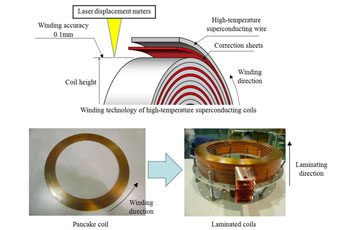Small Model MRI Uses High-Temperature Coils
By MedImaging International staff writers
Posted on 02 Jun 2016
A groundbreaking 3-tesla magnetic resonance imaging (MRI) system uses high-temperature superconducting coils that do not require cooling with increasingly scarce liquid helium.Posted on 02 Jun 2016
Developed by Mitsubishi Electric Corporation (Tokyo, Japan), Kyoto University (Japan), and Tohoku University (Japan), the small model MRI has an imaging space 25 millimeters in diameter with field homogeneity of less than two-millionths, the same level required for commercial-size MRI with a 230-mm diameter. The model succeeded in imaging a 25-millimeter mouse fetus at 3 tesla. The size of the system will be increased to one half of a full-size MRI scanner by 2020, with the aim of commercializing a full-size version from 2021.

Image: Winding technology of the high temperature super-conducting coils (Photo courtesy of Mitsubishi Electric).
The strong, stable, 3 tesla magnetic field was achieved by increasing the precision of the coil winding. Commercially available MRIs use low-temperature superconducting wires with a 2-3 mm round or square cross section wound several hundred times to create a pancake coil. Small discrepancies in the thickness and width of the wire give the coil an uneven height that can disrupt the magnetic field and distort imaging. This is overcome in the small model MRI by using high-temperature superconducting wires 0.2 millimeter thick and 4-5-millimeters wide.
Laser displacement meters were used to measure the coil height and then adjust it with correction sheets. This resulted in a winding accuracy of 0.1 millimeter for pancake coils with an outer diameter of about 400 millimeters, achieving the magnetic field homogeneity required for commercial imaging. Since the high-temperature superconducting wires used can direct more current than low-temperature ones with the same cross sections, and are able to generate magnetic fields with smaller coils, the size of the electrical circuits’ of the MRI can be reduced.
Superconducting coils are differentiated into low-temperature and high-temperature systems. In low-temperature MRI systems, the superconducting coils and analytical instruments are cooled to minus 269 degrees Celsius by applying liquid helium. However, liquid helium is a limited and depleting resource, due to the low number of gas fields and rising demand from developing countries. The use of high-temperature superconducting coils is therefore expected to increase.
Related Links:
Mitsubishi Electric Corporation
Kyoto University
Tohoku University








 Guided Devices.jpg)





